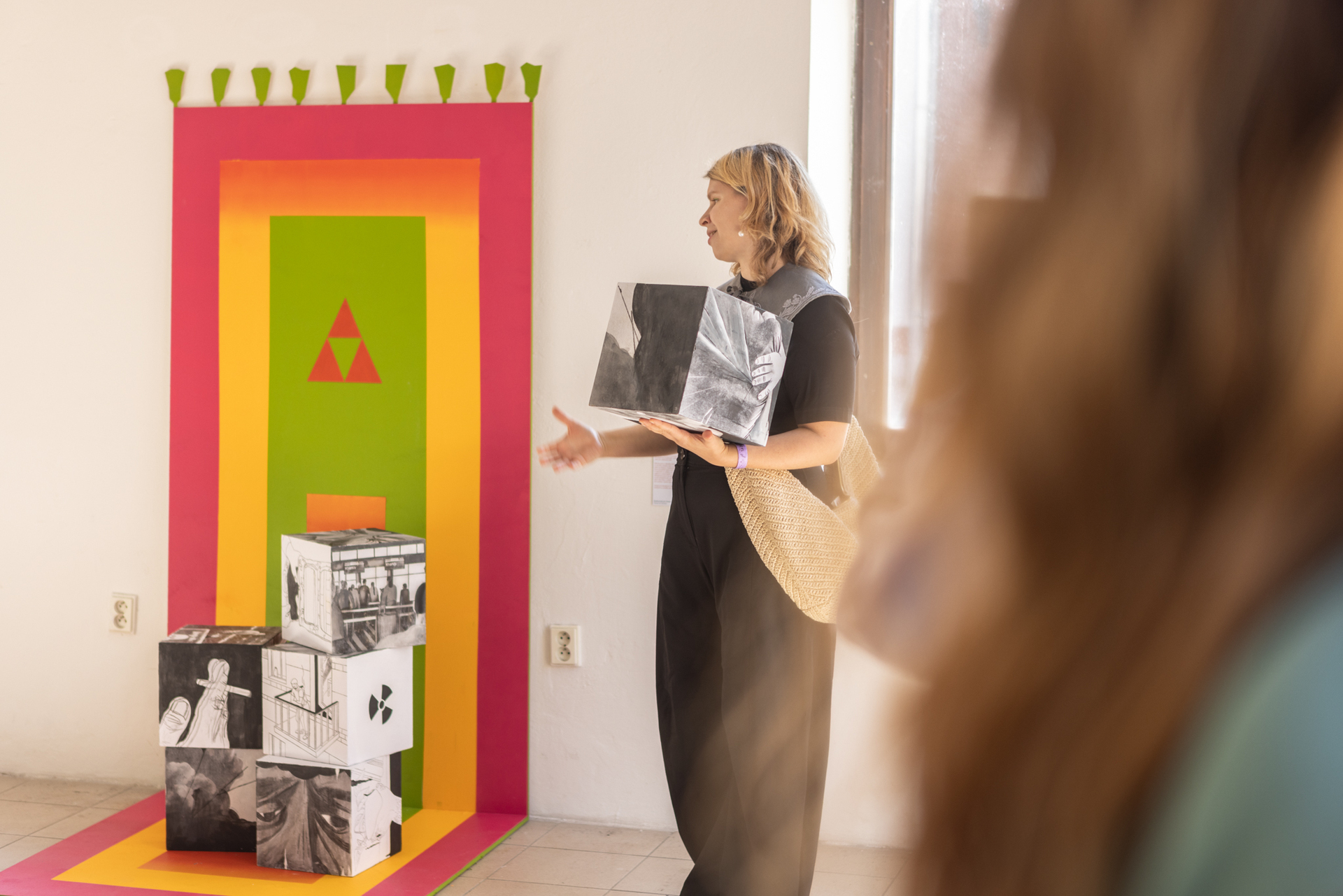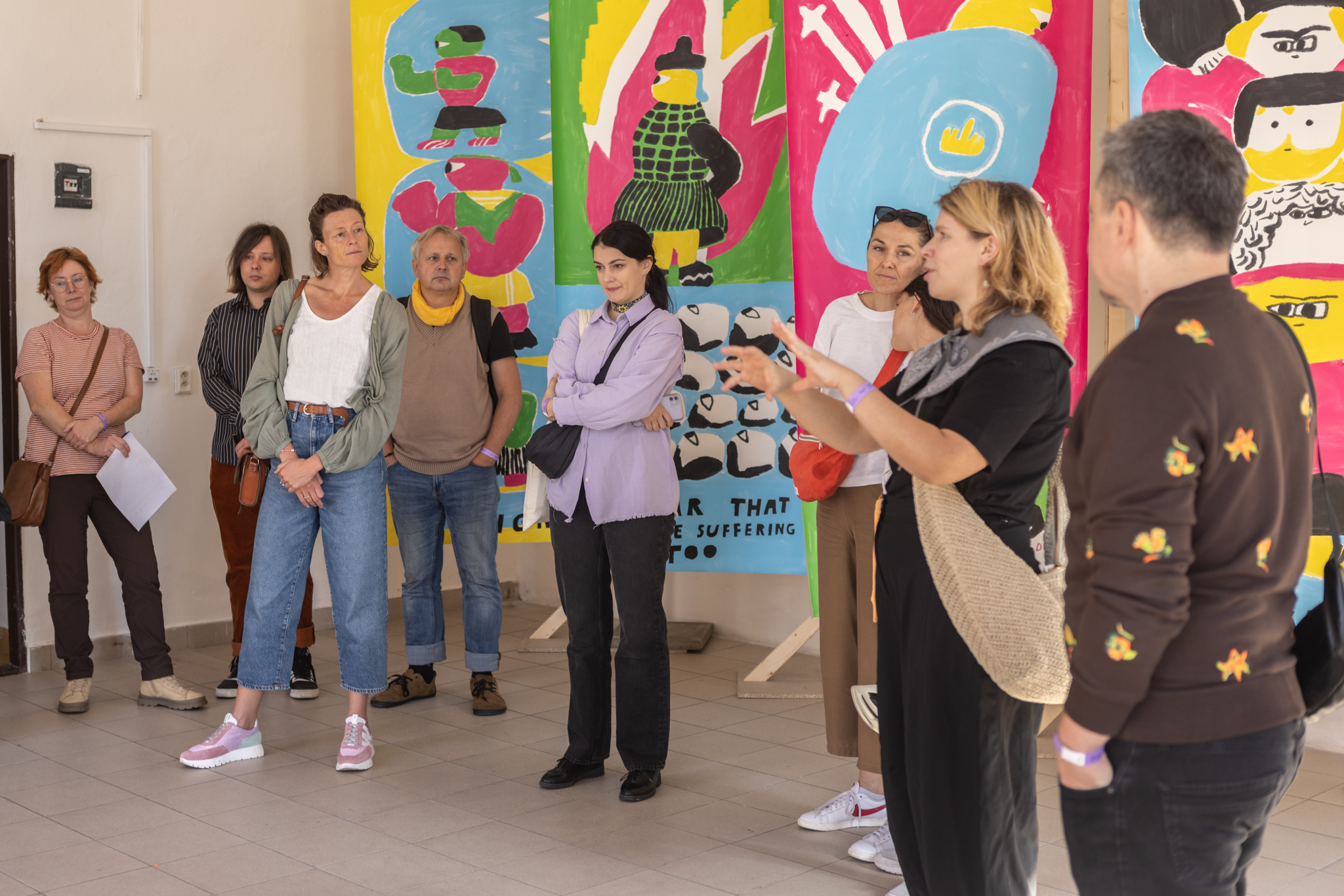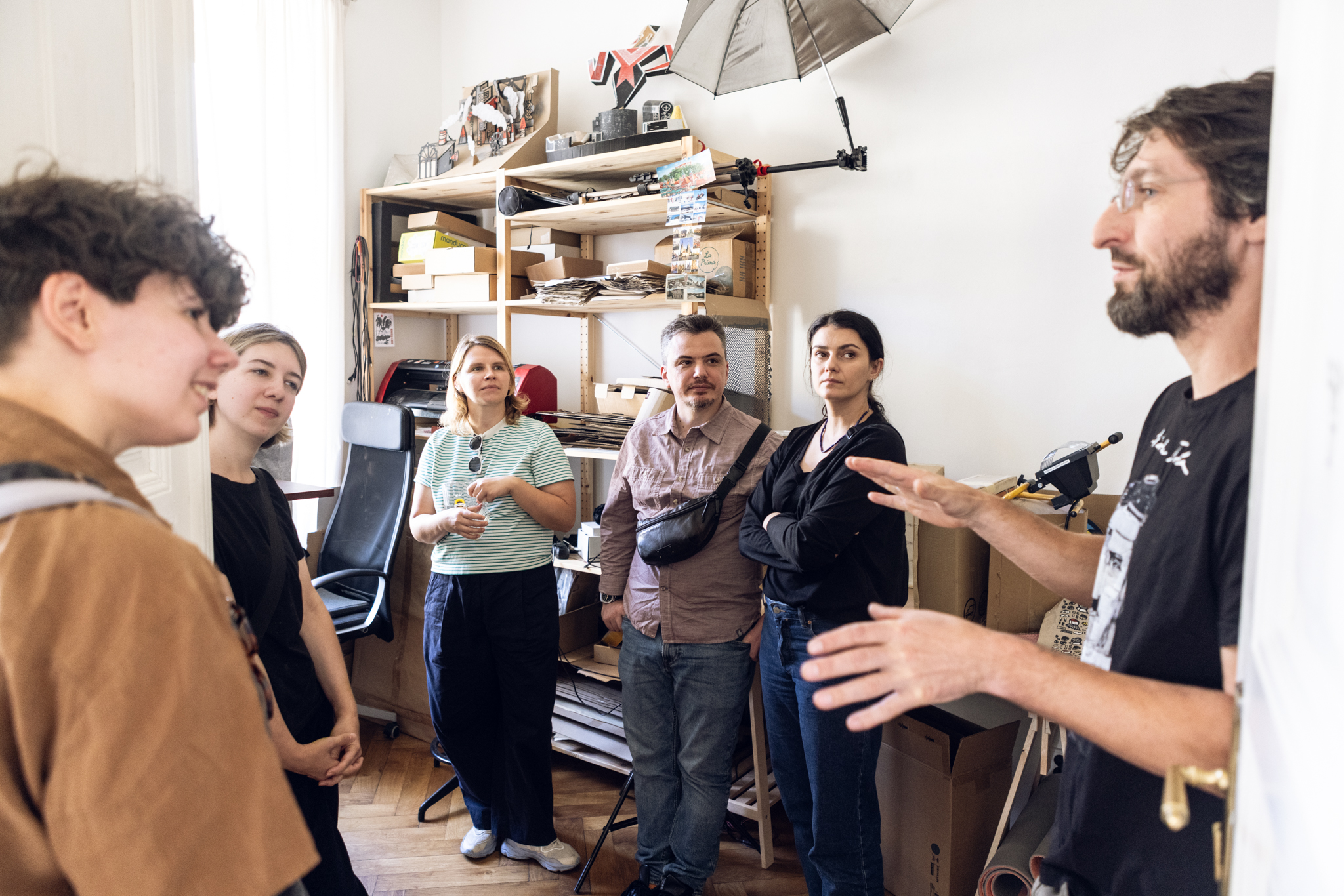ZMINA: Rebuilding | The Future for Ukraine: Art, Resilience, and Rebuilding at LUSTR Festival

The LUSTR Festival in Prague has long been a celebration of illustration, a place where artists from around the world converge to share their work and ideas. In September 2024, the festival took on an even greater role: becoming a platform for Ukrainian artists navigating the realities of war, resilience, and the process of cultural restoration. Under the framework of ZMINA: Rebuilding, artists participated in exhibitions, discussions, workshops, and an artist residency programme, creating new works that reflect both the challenges and hopes of contemporary Ukraine.
Through these events, LUSTR not only showcased the power of Ukrainian illustration but also encouraged cross-border collaboration between Ukraine and the EU. The festival served as a temporary hub for Ukrainian illustrators and creatives working on themes of resilience, rebuilding, and cultural collaboration.
The event demonstrated how illustration, often considered a ‘beautiful medium’, can become a powerful tool for storytelling, advocacy, and historical documentation.
A Festival Beyond Showcasing Art
The presence of Ukrainian artists at LUSTR was not just about exhibiting their work; it was about providing them with opportunities to engage with the international illustration community, experiment with new ideas, and reflect on how illustration plays a role in rebuilding identity, culture, and society.
Anna Sarvira, a Ukrainian illustrator and curator who relocated to Germany during the war, emphasised the importance of these interactions. “Through illustration, we can capture not only the facts but also the emotions, making them impossible to ignore,” she said. "Rebuilding is a very abstract thing—even for Ukrainians," says Anna. "It is hard to imagine. When I speak with people from Syria, I see that they face similar struggles. At the beginning of the war, we had photography capturing the destruction, but illustration can do something different—it expresses emotions, the abstract aspects of loss and hope. It allows us to talk about things that photography might be too brutal to capture." Anna, together with Oleg Gryshchenko and Olena Staranchuk, founded the Pictoric Illustrators Club in 2014, an independent cultural organisation focused on organising illustration and graphics exhibitions in Ukraine and abroad. Her role at the LUSTR festival was crucial; she curated the exhibition and helped select the participating artists.
The festival also marked a continuation of LUSTR’s commitment to supporting Ukrainian artists. LUSTR’s co-organiser, Nadia Bilinova, explained: “We had been showcasing Ukrainian illustrators before, but after the full-scale war began, it became even more important to provide a space where their voices could be heard.“

Before ZMINA: Rebuilding, LUSTR had limited experience with artists’ residencies, having organised their first one two years ago with Serbian artists. Initially, they aimed to showcase Ukrainian illustrators, and when they came across the ZMINA initiative, it provided a great opportunity for collaboration.
LUSTR saw the festival as a way for Ukrainian artists to gain international exposure, learn, and build connections. “In the Czech Republic, many people are influenced by propaganda, so we felt it was important to bring Ukrainian artists here—to share their perspectives and counter misinformation,” added Nadia. With around 4,000 visitors annually, LUSTR engages both professionals and the general public, making cultural exchange a key part of its mission.
Art as a Form of Reflection
Illustration as a medium allows for storytelling beyond war, offering both commentary and hope. The residency featured works by several artists who explored different facets of Ukrainian resilience and identity, and throughout the residency, they pushed the boundaries of their usual practices.
_Dita%20Havra%CC%81nkova%CC%81_10.jpg)
Oleg Gryshchenko, a professor at the Art Academy in Kyiv, drew inspiration from Bruno Schulz’s murals, which were destroyed during WWII. His project involved interpreting and reconstructing missing parts of historic murals, linking Ukraine’s cultural heritage to its present challenges, symbolising both loss and reconstruction. The missing parts of the murals are reimagined interpretations of the originals. For instance, Anna Sarvira sees the absent male head in a mural as a symbol of missed opportunities, while a flower represents a bright future—hope for what lies ahead.
Anna Andreeva, typically not an animator, experimented with animation during the residency. Her work visualised the psychological trauma of war, representing what happens in people’s minds.
_Dita%20Havra%CC%81nkova%CC%81_12.jpg)
Anna Sarvira has created a series of large-scale posters – tips for a happy future. "It’s easy to forget what happened," she explains. "My grandparents remembered war, but for me, before 2014, war was not part of my present. Now, it is. That’s why I made these reminders—Be ready to not forget. Be ready to make friends. Be ready."
Beyond individual projects, the residency fostered a collaborative learning environment. "There are not many opportunities where artists can just try things out, where there is space and time for creative risk-taking," says Anna.
“This residency gave us that power. It was inspiring to work in a safe environment with different artists and participants. After COVID, I started attending events again, and I realised how important these connections are.”
Anna Sarvira, illustrator and curator
The Residency: A Safe Space for Experimentation
A central component of the Future for Ukraine project was the artist residency, which took place in Prague before and throughout the LUSTR Festival. While the residency itself lasted 22 days, it was preceded by online meetings throughout the summer, allowing participants to discuss ideas and prepare their creative approaches. Anna Sarvira also made an offline visit to Ukraine, ensuring deeper engagement with the artists.
Ukrainian illustrators were given the opportunity to work in a safe and supportive environment, away from the immediate pressures of war. The residency provided a platform for both artistic experimentation and personal reflection, allowing the artists to push their creative boundaries in ways they might not have explored otherwise. "Having the time and space to work safely was incredibly important," said Anna. "This residency was not about creating polished works but about exploring, trying new things, and seeing where they could take us."
Throughout the residency, participants engaged in discussions on the role of media in storytelling and the ways in which illustration could convey experiences beyond the capacity of photography. "Illustration is a powerful medium," said Anna. "While photography captures a moment, illustration can express emotions, abstract realities, and the complex psychological impact of war."
The artists also worked with interactive installations, such as the cubes project, which encouraged visitors to construct their vision of Ukraine’s future. "We wanted people to actively engage," explained Anna. "Building from cubes symbolised how we are all constructing the future, piece by piece, sometimes in ways that feel unstable, but always with the possibility of something new."
Beyond War: The Future of Ukrainian Illustration
While war remains an unavoidable reality, Ukrainian artists at LUSTR were equally eager to explore themes beyond conflict. ZMINA: Future for Ukraine was not just about documenting the war; it was about envisioning what comes after. The exhibition Yellow and Blue—originally started in 2016 and revived for LUSTR—focused on Ukrainian culture, traditions, and everyday life beyond the war.
“It’s important to remind people that Ukraine is not only a place of destruction,” Anna Sarvira noted. “There is so much richness in our culture, and it deserves to be seen.”
This approach marked a shift in how Ukrainian illustration is perceived. In the immediate aftermath of Russia’s full-scale invasion, exhibitions around the world focused almost exclusively on war-related themes. But now, there is a growing effort to showcase the broader spectrum of Ukrainian art. “At that time, it was necessary. But now, we must also highlight Ukrainian culture beyond the war—to tell stories about who we are, not just what we are resisting.”
Collaboration was another major theme. The networking opportunities at LUSTR led to new partnerships, including plans for an illustration festival in Kyiv and exhibitions in Germany. “People are open to collaboration because of the war,” Anna noted. “We met partners at LUSTR who are now interested in working with Ukrainian artists long-term. That’s one of the most important outcomes of this festival.”
Lessons for the Creative Sector
One of the key takeaways from ZMINA: Rebuilding was the importance of collaboration and cultural exchange. Many artists emphasised that the networking opportunities at LUSTR had opened doors for future projects. The festival demonstrated the importance of fostering long-term collaborations. The connections made at the festival will continue to shape projects and partnerships between Ukraine and the EU. “Networking events might seem like a side activity,” said Nadia Bilinova, “but they are crucial. This is where projects are born, where ideas take root. Without these connections, many of these collaborations wouldn’t happen.”

The festival also underscored the need for residencies that provide space for artistic experimentation. "There are not many opportunities where artists can simply try things without immediate pressure," said Anna Sarvira. "Festival LUSTR gave us that chance, and it was incredibly empowering."
For the broader creative sector, Ukraine’s experience exemplifies how culture and illustration contribute to national resilience. As Anna put it, "Illustration is often seen as something decorative, something that makes things look nice. But it can be strong, political, and transformative. It can change how people see the world."
Looking Ahead
As LUSTR looks to the future, its commitment to supporting Ukrainian artists remains strong. Discussions are already underway for future collaborations, exhibitions, and projects. Meanwhile, Ukrainian illustrators persist—experimenting, creating, and shaping the visual identity of Ukraine’s future.
“We don’t know exactly what the future will look like,” reflected Anna Sarvira. “But through illustration, we can start to imagine it.”
Author: Mária Beňačková Rišková
ZMINA: Rebuilding is a project co-funded by the EU Creative Europe Programme under a dedicated call for proposals to support Ukrainian displaced people and the Ukrainian Cultural and Creative Sectors. The project is a cooperation between IZOLYATSIA (UA), Trans Europe Halles (SE) and Malý Berlín (SK).